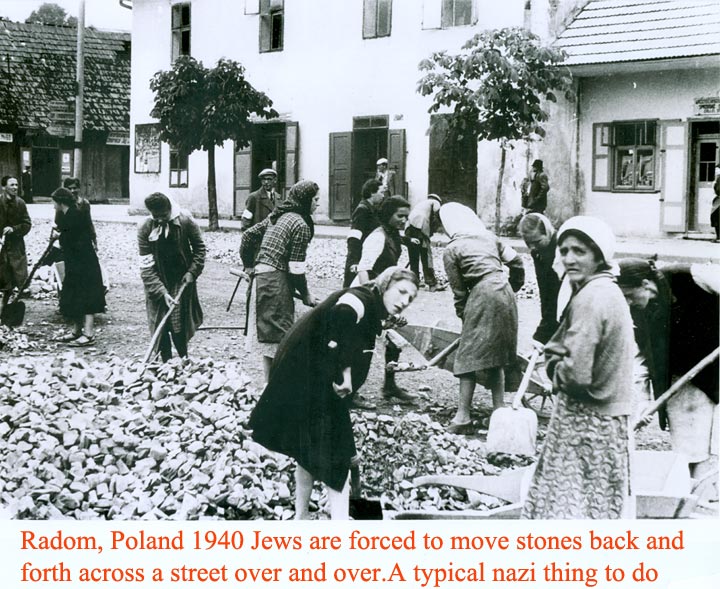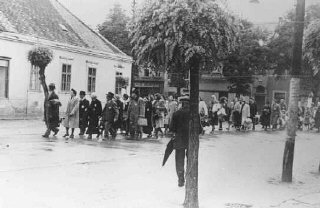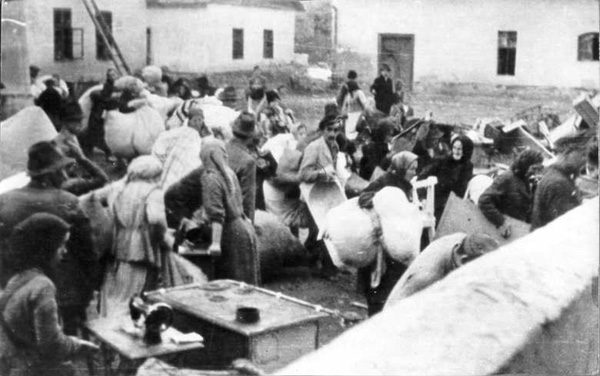|
To go back to Page One of Memorial Click This Link
Here
After the Germans had invaded Hungary and installed a more Pro-Nazi Goverment Jewish Persecution is stepped up.There are more laws passed forcing Jews to wear a yellow star,taking away property,taking away money,telling Jews where they are now allowed to go in public......... little by little the Jews rights are stripped away and then in April 1944 Jews are rounded up and forced into makeshift Ghettos until transportation to Auschwitz is arranged.Most Jews from the Southern part of Carpathia will end up in a small town called Mate-Szalka in northeast Hungary.There the Jews are put into a field where they will live until the trains arrive to take most to their deaths.They will be in this makeshift Ghetto for about a month.Jews are forced to do manual labor and in these next three pictures we see Jews in Ghettos forced to do manual labor.
The Ghettos and the DestructionWith the penetration of the German tanks into Hungary on Sunday, March 19, 1944 (23 Adar 5704) a sharp turning point arrived regarding in the fate of Hungarian Jewry. Decrees against the Jews followed one after the other with murderous speed. Within 6 weeks, the Jews of Hungary were concentrated in ghettos in preparation for deportation to Auschwitz and total destruction. The 60,000 Jews of Marmaros who had survived the deportations and slaughters of the summer of 1941 were concentrated into 12 ghettos, 3 of them outside Marmaros.In Romanian Marmaros there were 4 ghettos: Sziget, Berbest, Ober-Wisho and Dragomirest: (1) Ghetto Sziget was established between 18-20 April, 1944. Actually, there were 2 ghettos in Sziget: the large ghetto within the city consisted of 4 streets where the Jews lived, and the small ghetto established in the slum-suburb “Ober-Yarash”, containing several tiny alleys where the rural Jews, who had previously been held in ghetto Berbest were placed (see below). In the large ghetto 11,000 Jews from the city itself and from 2 or 3 nearby villages like Wiresmort etc., were concentrated. Living conditions in the ghetto were appalling. In middle-sized rooms, 8-10 people were crowded and into larger rooms, up to twenty. From 5:00 p.m. until the following morning, it was prohibited to be found outside of one's room. At the end of April, a delegation planning the destruction of Hungarian Jewry visited the ghetto, headed by Adolf Eichman on the German side and Laszlo Endre on the Hungarian side, and accompanied by employees of the Ministry of the Interior and by doctors. The purpose of the visit was to “study” the Jewish problem at one of the first ghettos in the country, to observe the conduct of the Jews and their state of mind, how cognizant they were of the fate awaiting them, the influence it would have on the non-Jewish population, the degree of cooperation that the government could anticipate from them. (2) Ghetto Berbest was a branch of Ghetto Sziget. It contained about 3,000 souls. Before being deported to Auschwitz, the residents of the Sziget ghetto were transferred here to “Ober-Yarash”, the Sziget suburb where Ghetto Berbest was located. From there, the Jews were taken to Auschwitz. In Ghetto Berbest Jews from the following villages were also concentrated : Uncsest, Budest, Birsanif, Wad, Valeny, Selist, Nanest, Serb, Kalinest, Akna-Sugatag, Sugatag (village), Remit, Ferest, Desest, Sanapotek, Horints, Huten, and Kracest. The deportations from Sziget-Berbest were carried out in 4 stages. The first took place on 17 May 1944, from ghetto Berbest (“Ober-Yarash”). There followed deportations from the larger Sziget ghetto on 18 May 1944, 19 May 1944, and again on 21 May 1944. These were among the first deportations from any ghetto in Hungary. (3) Ghetto Upper Wisho was established from the 16-23rd of May, 1944, in the center of the city on the “Jewish Street” and on three other small streets leading from it. The crowding here was insufferable. 20-30 people were quartered in one room. An attendance roll-call lineup was held every day, sometimes lasting several hours. In the line-up there were also beatings. The food rations that were provided were very meager. Some of the men were taken for various labor-projects, especially wood-cutting. They were over-worked, while weak and starving. The German- Hungarian delegation mentioned in Ghetto Sziget visited this ghetto as well. It is worthwhile to note that one of the members of the delegation, Laszlo Frantzi, who was the liaison officer between the “Einzatzgruppen” of Eichman and the command of the Hungarian gendarmerie, was a native of Upper-Wisho. He was one of the most active murderers of Hungarian Jewry. He travelled from ghetto to ghetto during the deportations and it was he who supervised the atrocities. He was executed in 1946 in Budapest. This ghetto contained about 13,000 souls. In addition to the 4,000 local Jews, also concentrated in Ghetto Upper-Wisho were also Jews from the following places: Lower-Wisho, Middle-Wisho, Borsha, Bistra, Viso-Volgy, Lerdine, Masif, Polien Riskeve, Petreve, Krive, Riskeve. The Jews of this ghetto were deported to Auschwitz in 3 transports between the 17th-23rd of May, 1944. (4) Ghetto Dragomirest was established in the center of the village as of April 15th. In addition to the 700 local Jews, others from the following villages were concentrated there: Butiza, Glod, Yoid, Strimtere, Slatina, Selist, Polien-Glod, Kechnie, Rezavlia, Sif. This was one of the smaller ghettos in the entire country and 4,000 people were held here (not as we wrote in the article about Dragomirest). Ghetto Dragomirest was relatively more comfortable than the other ghettos. The lack of food was hardly felt there. The surrounding farmers and especially the farmers' wives brought packages of flour, oil, milk, butter and vegetables to the ghetto. From time to time, the Jews who had lived in neighboring villages were permitted to return home and bring food supplies which had been left in their abandoned houses. In contrast to this, the deportation was a trail of suffering. The 25 kilometers to the train station of Wisho, from which they were deported to Auschwitz, was a trip strewn with anguish. The men were forced the entire way up the steep mountaintop on foot. The gendarmes pushed the marchers onward with blows from their rifle-butts. Many victims fell along the way. Ghetto Dragomirest was liquidated on May, 15, 1944, the victims being loaded onto the trains to Auschwitz. (5) Ghetto Mateszalka. This town is in the Satmar District (in the Hungarian sector, west of the boundary that crosses the Satmar District). In this town, there were 1,555 Jews in 1941 among a total population of 10,036. Here was one of the large concentrations of Jews before their deportation for annihilation at Auschwitz. In the ghetto 17,000 Jews were gathered. A small fraction of this population came from the town itself and several small communities in the area, but the great and overwhelming majority – approximately 15,000 – were brought from over 30 places in Marmaros. This was the largest single concentration of Marmaros Jews, although Mateszalka itself is located outside of Marmaros. The conditions of this ghetto were shocking, and among the worst - perhaps the worst - of all the ghettos in Hungary. At first, the Jews were concentrated outdoors. After some time, they were tranferred to small shanties, most of them temporary. The Marmaros Jews suffered doubly here. For in addition to the usual suffering of all the inmates of the ghetto, the Jews of Marmaros also suffered because they were torn from their natural environment and were brought to foreign surroundings. Among the settlements whose Jews were brought to ghetto Mateszalka were: Larger towns having more than 1,000 Jews: Ober-Apsa, Bicskof, Bistina, Iasin and Rahov. Places with a population of 500 and over: Iglya, Ganice (in part, the other part was sent to ghetto Tecs), Teresif, Terneve, Neresnitza. Smaller settlements, numbering less than 500 Jews were: Apsicsa, Bogdan, Bedevle, Bilvaritz, Bilin, Brister, Harisof, Vilhovitz, Tiska, Trebusan, Leh, Niagova, Polien-Kosoviczki, Kalin, Kereczky, Kolodna , Krasnisora, and Krive (Czech). (6-10) [Five ghettos were established within a relatively small area of southwestern Czech Marmaros. They were located in the towns Chust, Tecs, Slatfina, Iza, and Sikernica.] According to one testimony, the situation [in the Sikernica ghetto] was made bearable due to systematic food supplies. In the ghetto 4,000 Jews were crowded together. In addition to the Jews of Sikernica, Jews from the following surrounding villages were brought there: Danilev, Drahiv, Mikif, and Sandrif. Jews were also brought there from more distant places, such as: Volovo, Negreviz, and Kalicsava (which in fact were connected to Sikernica by the main road). The ghetto was liquidated on the holiday of Shavuos 5704 (28th and 29th of May, 1944). (11-12) Ghettos Munkacs and Bergsas. Jews from the towns and villages along the western border of Marmaros were taken to these two ghettos. Jews from the following places were put into the Munkacs ghetto: Bereznik, Sico-Branko, Zadna, Lisitse, Kereczky, Rustuka. The Jews of Vilchovitz in the “Dibever Rika” were also brought to ghetto Munkacs, for a special reason: Since a typhus epidemic “broke out”, they said, among the Jews of Vilchovitz and they required quarantine, they were brought to Munkacs where special provisions were made for their quarantine. A total of about 2,000 Jews from Marmaros were in ghetto Munkacs. Less than 1,000 Marmaros Jews were sent to ghetto Bergsas, and only from 2 or 3 places: Dolha, Kushnitza and perhaps also from Upper Studena. Thus, we see that the Jews who lived on the Czech side of Marmaros were concentrated into 8 ghettos, 3 of which, as was said, were not within Marmaros itself. We were not able to fathom the thinking of the authorities who organized the ghettos of Czech Marmaros the way they did. We were not able to discover the “logic” which guided those who chose the concentration sites. It seems that the entire eastern region, along the length of both tributaries of the Tisa (the Black and the White), as well as the settlements in the south along the length of the river (after both tributaries join) were brought to the ghetto of Mateszalka. But if that was the case, then why were some of the settlements of the “Dibever Rika” sent to ghetto Mateszalka and others to ghetto Tecs? And then also why in a relatively small area in the southwest were 5 ghettos established - Chust, Tecs, Slatfina, Iza, Sikernica - while in the entire region in the east and north not a single ghetto was set up, despite the fact that there were several settlements there with a significant Jewish population, including Iasin, Rahov, Viso-Volgy, Maidan, etc.? And again, why were the Jews of Bistina, which lies on the railroad-line and on the main road connecting Tecs-Bistina-Sikernica-Chust brought to ghetto Mateszalka, despite the fact that there were 2 ghettos located relatively nearby in the northeast (Sikernica and Chust) and one in the southeast (Tecs)? Such questions arise in other places as well like the Apshas - while the Jews of Middle-Apsha and Lower-Apsha were brought to ghetto Slatfina, why were the Jews of Upper-Apsha brought to ghetto Mateszalka? There is no justification for this in terms of communication lines. It seems clear, then, that minimal advance planning was done in organizing the deportation of the Marmaros Jews to their destruction. Rather it was all done hastily, with minimal planning. For 19 settlements in Marmaros, we could not trace the ghettos from which they were deported to Auschwitz: From the area of Volovo, the following nine: Bikivics, Huliatin, Vicski, Lahoviz, Lizansk, Navaselicza (near Volovo), Prislop, Ricske, Ripina; From the Tecs area, the following eight : Dibeve, Csmolif, German Mokra, Russian Mokra, Novoseliza (in Dibever Rika), Padaflesa, Kenigsfeld, Kricsif; The village Saldobus in the Chust area; The village Polien-Kabileczky in the Rachov area. No Jews were deported from 4 places in 1944, simply because there was no one left to deport. They had already been deported and most of them murdered in the deportation decrees of the summer of 1941. Those who escaped - as few as there were - did not return to their villages but sought out new places to settle. Some also reached Budapest where it was easier to slip away. Those four villages which were already “Yudenrein” in 1941 are : Vermezif, Torn, Terebla and Terisel. It is almost definite that there were some more such villages, but they are not known to us.
Peasants Looting Jewish Ghwttos 1944
|

 Kosveg Jews Deported
Kosveg Jews Deported